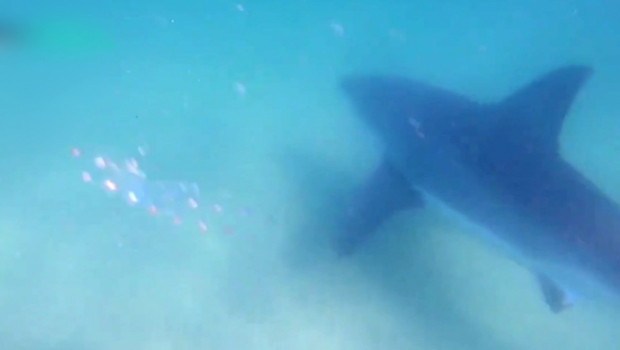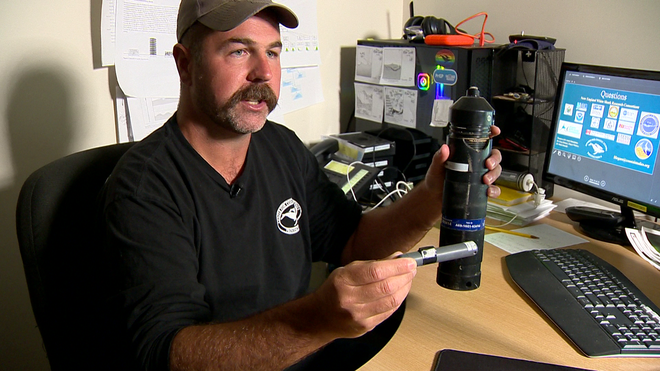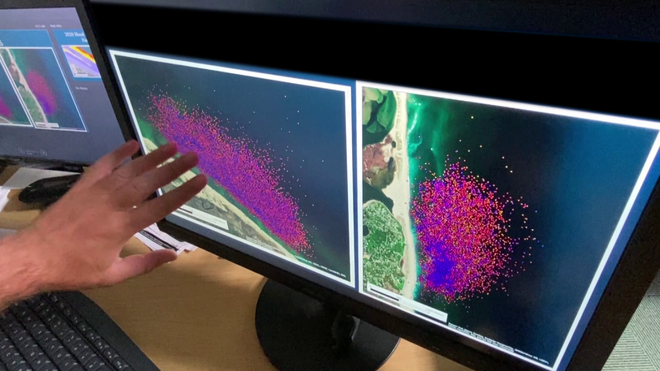New technology gives glimpse of true shark activity off Outer Cape beaches
Shark season is underway on Cape Cod, and that means more shark sightings, more beach closings, and more concern.But under the water, out of sight, little-discussed tracking technology is revealing a truer picture of the amount of great white shark activity just off the coast of the outer Cape.Bryan Legare, manager of the shark ecology research program at the Center for Coastal Studies in Provincetown, uses multiple receivers to monitor tagged sharks when they come near a beach. There have been 269 sharks tagged since 2009.Off the coast of Truro, for example, he's been able to track what amounts to a shark patrol, moving back and forth between one sandbar and a second outer sandbar.An image of the tracked sharks, picked up by 15 receivers off the Head of the Meadow beach, shows about 60 tagged sharks passed through during the summer of 2020.It shows that half of the time, a tagged shark was present. And that doesn't include non-tagged sharks, which are certainly out in the water, Legare said.This year, Legare will be monitoring five outer Cape beaches: Head of the Meadow, Nauset, Marconi, Newcomb Hollow, and Herring Cove."It really hits the ball out of the park when you're seeing these visualizations of beaches that you know and areas that you know and how even just one shark moves through the area versus the dozens and dozens of sharks that we've tracked," he said."Do the findings make you more likely or less likely to want to go into the water?" 5 Investigates' Mike Beaudet asked Legare."I absolutely look at my data and say I'm going to be extremely respectful of when these sharks are in these areas and how they're using the habitats," Legare said.The Lowes have been vacationing on the Outer Cape for years."It's a little scary. I mean I'm actually surprised by that, but I guess not because there's so many seals," Roxanne Lowe said.They know sharks are in the area, but they didn't realize how frequently they're in shallow water near beaches."It really makes you second guess how far you're going to wade out into the water," Lowe said.How many sharks are swimming around the five beaches now being monitored won't be known until after Labor Day. That's when the receivers will be removed, and the shark data will be retrieved and analyzed. August is typically the peak month for tagged shark detections on the Cape, followed by September and October. Legare, the researcher, said beachgoers should not panic because of what his trackers have found."It actually gets me more comfortable about what's going on in the beach," he said. "And knowing how often these sharks are in the water and how infrequent negative interactions are."He added: "It's just absolutely fascinating seeing these tracks, but also from a perspective of providing information to the public, people can directly see how this feeds into public safety and beach management."
Shark season is underway on Cape Cod, and that means more shark sightings, more beach closings, and more concern.
But under the water, out of sight, little-discussed tracking technology is revealing a truer picture of the amount of great white shark activity just off the coast of the outer Cape.
Bryan Legare, manager of the shark ecology research program at the Center for Coastal Studies in Provincetown, uses multiple receivers to monitor tagged sharks when they come near a beach. There have been 269 sharks tagged since 2009.
Off the coast of Truro, for example, he's been able to track what amounts to a shark patrol, moving back and forth between one sandbar and a second outer sandbar.
An image of the tracked sharks, picked up by 15 receivers off the Head of the Meadow beach, shows about 60 tagged sharks passed through during the summer of 2020.
It shows that half of the time, a tagged shark was present. And that doesn't include non-tagged sharks, which are certainly out in the water, Legare said.
This year, Legare will be monitoring five outer Cape beaches: Head of the Meadow, Nauset, Marconi, Newcomb Hollow, and Herring Cove.
"It really hits the ball out of the park when you're seeing these visualizations of beaches that you know and areas that you know and how even just one shark moves through the area versus the dozens and dozens of sharks that we've tracked," he said.
"Do the findings make you more likely or less likely to want to go into the water?" 5 Investigates' Mike Beaudet asked Legare.
"I absolutely look at my data and say I'm going to be extremely respectful of when these sharks are in these areas and how they're using the habitats," Legare said.
The Lowes have been vacationing on the Outer Cape for years.
"It's a little scary. I mean I'm actually surprised by that, but I guess not because there's so many seals," Roxanne Lowe said.
They know sharks are in the area, but they didn't realize how frequently they're in shallow water near beaches.
"It really makes you second guess how far you're going to wade out into the water," Lowe said.
How many sharks are swimming around the five beaches now being monitored won't be known until after Labor Day. That's when the receivers will be removed, and the shark data will be retrieved and analyzed. August is typically the peak month for tagged shark detections on the Cape, followed by September and October.
Legare, the researcher, said beachgoers should not panic because of what his trackers have found.
"It actually gets me more comfortable about what's going on in the beach," he said. "And knowing how often these sharks are in the water and how infrequent negative interactions are."
He added: "It's just absolutely fascinating seeing these tracks, but also from a perspective of providing information to the public, people can directly see how this feeds into public safety and beach management."











Gloss